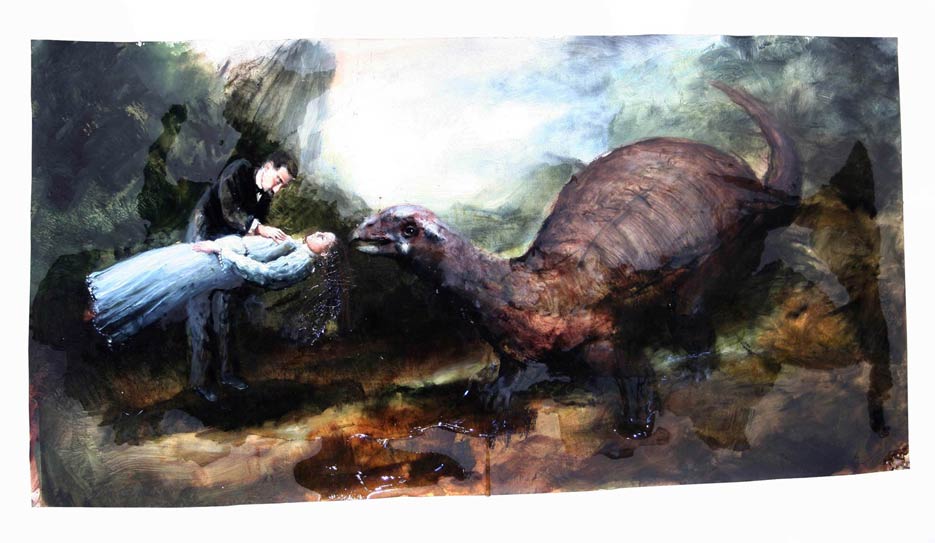

|
(.....) Lehmanns Gemälde der realistischen und naturalistischen Malereitradition zuzuordnen, ist trotz der teils absurd- surreal wirkenden und mit einem Hauch von Magie umsponnenen Motive durchaus nahe liegend. Denn Andrea Lehmann ist eine Malerin, die dem Realismus der Seele nachspürt.
Thomas Eakins beispielsweise wurde seinerzeit für sein realistisches Gemälde „The Gross Clinic“ berühmt. Das Bild entstand 1875 und zeigt einen chirurgischen Eingriff in einem US- amerikanischen Hörsaal, in dem Studenten den menschlichen Körper erkunden. Auf ihre Art und Weise vollzieht Andrea Lehmann auch nichts anderes als Eingriffe. Die Erschließung des menschlichen Körpers beschränkt sich aber nicht auf die Erkundung der Organe. Lehmann interessiert das Immaterielle, das Sphärische. Ihre gemalten Protagonisten offenbaren einem sogar das eigene Herz. Da die Herzgegend auch als der Ort angesehen wird, an dem die menschliche Seele zu finden ist, stellen Lehmanns fragile Papierarbeiten riskante Operationen am offenen Herzen dar, bei denen es gilt, die unsichtbare Seelentätigkeit künstlerisch in Erscheinung treten zu lassen. In diesem Zusammenhang sind die Tierwesen helfende Weggefährten. Die das empfindliche Papier bevölkernden Zwischenwesen, die Pferde, Bären, Schafe und die Vögel müssen adjektivisch verstanden werden, da sie auf die innere Beschaffenheit eines Menschen verweisen. Die Tiere, sei es nun in ihrer Gänze oder als Zwischenform mit menschlichem Unterbau, sind sozusagen übersetzerisch tätig, geben über das jeweilige menschliche Dasein Auskunft und transportieren das Innere nach Außen. (.....) Claudia Cosmo, Oktober 2013 (.....) Despite her at times absurd and surreal pictorial motifs, garnished with a touch of magic, it seems natural to associate Lehmann’s works with the realistic and naturalistic tradition of painting. For Andrea Lehmann is an artist who traces the realism of the soul. Thomas Eakins, for example, became famous in his day for his realistic painting The Gross Clinic. The picture was produced in 1875 and shows a surgical operation being performed in an American lecture theatre, where medical students are learning about the human body. Surgery is exactly what Andrea Lehmann performs, too, in her own way. Studying the human body is not confined to examining the organs alone, however. Lehmann is interested in the immaterial, the realm of the spheres. Her painted protagonists lay bare even their hearts. Given that the region of the heart is also viewed as the place where the human soul is to be found, Lehmann’s fragile works on paper represent risky open-heart operations, which aim to reveal the invisible workings of the soul through artistic means. In this context, the animal figures are helpful companions. The hybrid creatures that inhabit these delicate sheets, the horses, bears, sheep and birds, must be understood as having a descriptive, adjectival function, since they point towards a person’s inner nature. These animals, whether they appear in their entirety or as heads joined to a human body, act in the capacity of translators, supplying information about the human life in question and transporting its interior to the exterior. (.....) Claudia Cosmo, October 2013 |
|
|
|
Andrea Lehmann Biography Page > |